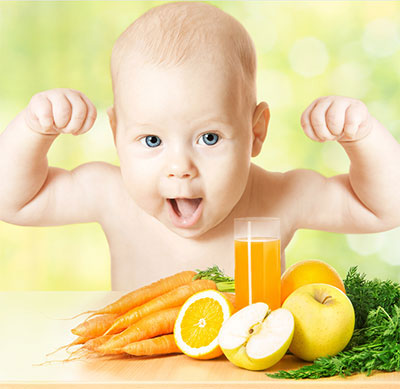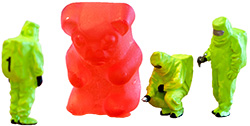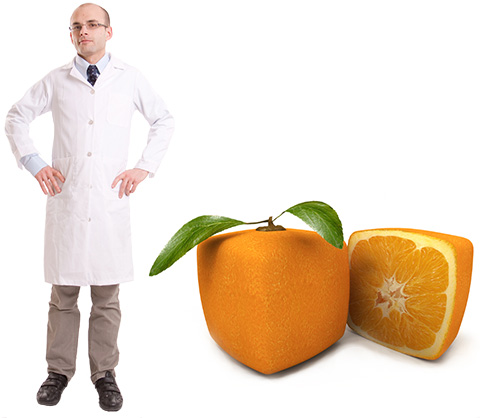Why Childhood Food Allergies Have Risen 50%

Childhood allergies are a very serious health issue in the US. The Centers for Disease Control and Prevention (CDC) reported in 2013 that from 1997 and 2011, food allergies increased by 50% in children.
Many children have food allergies now that did not exist a decade ago. Indisputably, food allergies are skyrocketing, leading parents to wonder what could be causing such a dramatic change. Our parents and grandparents had little to no memories of kids with debilitating intolerances and serious allergies to foods such as peanuts. Today, kids all over America are now developing allergies so serious that they are rushed to emergency rooms. Let's take a look at the root causes of this epidemic.
The answer is not complicated. It's no coincidence that allergies are rising in 1st world countries - countries that are considered medically innovative and technologically advanced. This is because there is a definitive link between the industrialization of our food chain, the chemicals in our environment, and the rise in chronic diseases and childhood allergies:
1. Chemicals (Cleaning Products / Household / Environmental)
In today's chemicalized world, we've been conditioned to fear germs to an unhealthy and irrational degree. Due to the aggressive marketing techniques of cleaning manufacturers, the American public has developed an unhealthy obsession with germs when it comes to the subject of bacteria. The fear-mongering has millions of Americans needlessly spending huge sums of money on toxic products in the belief that we must all lead highly sanitized lives. This obsessive need to eradicate all germs is unhealthy and does far more harm than good.
The Body Healer |
Concerned about their children's health, mothers are constantly sanitizing by scouring, bleaching, disinfecting, scrubbing, and spraying dangerous chemicals around their household. But these chemicals are often far more dangerous than the germs that we are trying to eliminate. Not only do they cause damage to our bodies, they are also a contributing factor to lowered immunity in our children. Household cleaning chemicals have been shown to increase the likelihood of various forms of cancer, allergies, asthma, and other health conditions.
A healthy body is inhospitable to disease
Our bodies are full of bacteria, viruses, and various microorganisms. They feed upon the toxic waste inside of us and are not an issue when our bodies are healthy. For example, cancerous cells are routinely created and destroyed by a healthy body on a daily basis, preventing these cells from developing into a cancerous condition.
Germs help strengthen our immune system. When they enter our body, our immune system stops them from invading our bodies by destroying them. It also creates something called an "antibody" which destroys the bacteria or virus if it later returns to our body. These antibodies are passed to infants via breast milk from mom. As we grow older, exposure to various germs helps the immune system learn and become stronger, each infection resulting in new antibodies to help fight against future infections. Sometimes, we experience a fever or a cold as our immune system clears away these germs.
Being exposed to common microbes such as the cold or flu helps teach our immune system to respond appropriately with antibodies, so that when we're exposed to more serious strains of bacteria, viruses, and allergens, our body is more prepared. Exposure to basic germs and dirt such as in the garden and around the home is important. Of course, it's also important to maintain basic sanitary habits such as washing our hands after going to the bathroom and keeping our homes clean. But obsessively worrying about cleanliness and the overuse of hand sanitizers and using household cleaners filled with toxic chemicals is very unhealthy and can lower our children's immune system, making them more susceptible to allergies and illnesses. Growing up as a kid, many of my friends grew up on farms filled with cows, sheep, chickens, dogs and many other creatures. There was no such thing as a sterilized environment and childhood sicknesses rampant today were practically unheard of. Allergies were rare and these kids were healthy, strong, and robust.
Ditch the Hand Sanitizers
As well as containing synthetic fragrances and dyes, many hand sanitizers now contain antimicrobial chemicals such as the antibacterial agent triclosan. Triclosan has come under the scrutiny of Canadian and US agencies as studies have linked it to endocrine disruption, altered hormones in animals, and it may also be damaging to the thyroid. A meta-analysis of 27 studies revealed that soaps with triclosan were no more effective than plain soap in preventing infections and reducing bacterial levels on the hands.(1) There is ZERO evidence that excessive antibacterial soap use results in fewer illnesses for your family.
2. Processed / Refined Foods & Lack of Nutrition

Getting the right nutrients from food is crucial for a healthy, strong body. From 2 years of age, it is time to begin teaching the important healthy eating habits that will set the tone for your child's long-term health and well-being. What foods are healthy foods for a growing child? Simply put, natural whole foods that are free of chemicals, processing, and genetic modifications:
Aim for 3/4 of your children's plate to be filled with fresh fruits and vegetables, and the remaining 1/4 from a mixture of the other food groups. When your child eats plenty of fruits and vegetables, they are eating a diet that is naturally high in water content, hydrating and nourishing them on a cellular level. Any drinks for children should consist of fresh water (add some orange and lemon slices!), coconut water, or fresh fruit and veggie juices/smoothies.
Don't Feed Children Supplements (most of which are synthetic chemicals)
 First of all, ask yourself why you are even considering giving supplements to your child. Supplements should only be used to treat a deficiency or health condition, and once that condition resolves, should be eliminated. There should never be a reason to give a child supplements if their diet is healthy, and if it isn't, then the answer is to fix the problem rather than provide fractionated nutrients in the form of these artificial chemicals. Studies definitively show that many commonly taken supplements such as folic acid and beta-carotene do more damage to the body than good. Unfortunately, most pediatricians are not nutritionists and are unaware of these studies.
First of all, ask yourself why you are even considering giving supplements to your child. Supplements should only be used to treat a deficiency or health condition, and once that condition resolves, should be eliminated. There should never be a reason to give a child supplements if their diet is healthy, and if it isn't, then the answer is to fix the problem rather than provide fractionated nutrients in the form of these artificial chemicals. Studies definitively show that many commonly taken supplements such as folic acid and beta-carotene do more damage to the body than good. Unfortunately, most pediatricians are not nutritionists and are unaware of these studies.
Why supplements are not the Holy Grail...
Most supplements are an artificial version of nutrients found in foods, nutrients that were never meant to be isolated. In whole foods, thousands of nutrients work together as a synergistic whole. We cannot extract a specific nutrient from that whole and expect it to do what it is supposed to do. Nature does not isolate chemical constituents because when they have been isolated, they no longer work as they should, nor are they absorbed as efficiently by the body. This is the reason most multivitamin and mineral supplements have extremely poor absorption rates.
3. Genetically Modified Organism (GMOs) & Antibiotic Resistance

Studies now link the increase in conditions such as ADD, autism, and childhood allergies with the consumption of both GMOs and foods treated with pesticides. As GMOs themselves are heavily treated with pesticides, this double-whammy creates a recipe for disaster.
Food Allergies are a Reaction to Proteins Found Within a Food
The DNA of an organism contains instructions for making proteins, but when food is genetically engineered, the altered DNA can, in turn, create new proteins. GM foods are designed to produce their own insecticidal toxins (to deter bugs) and introduce foreign proteins into our food chain that never existed before. Because the DNA of GM foods have been altered, the new proteins created may create new allergies to that GM food that did not previously exist, or allergies to other food proteins. Children are especially susceptible as 70% of a child's immune system is found within their digestive tract.
- A 2005 allergy and asthma study found that human subjects exhibited an immune response to GM soy, but not to non-GMO soy. This is because GM soy contains a different protein.(2)
In the absence of these studies, the only way to tell if GM foods contribute to health conditions is to completely remove them from the diet and see if the health condition improves or clears up. If you live in most countries around the world, including Europe, Australia, or Japan, this is not very difficult as GM foods are clearly labeled. But making this distinction is much more difficult if you live in the US, because the right to recognize GM foods is taken away from you. Labeling in the US is critical to give people the choice to opt out of these foods and their potentially hazardous health implications, rather than be part of one huge chemistry experiment.
How to avoid GMOs at the market...
What do GMOs Have to do With Antibiotic Resistance?
An antibiotic-resistant gene is placed in the GM plant, along with an herbicide-resistant gene. This means that the cells in genetically modified crops are bred to be antibiotic-resistant. Unfortunately, these antibiotic-resistant genes can then be picked up by bacteria in the soil and find their way into our water supply and our bodies. We are colonizing our healthy gut bacteria with antibiotic resistant bacterial genes.
- The Chinese tested multiple samples of public water and found that antibiotic-resistant bacteria are now in their rivers, with the conclusion that it originated from local genetically engineered crops.
- In a study in Europe on beets, the antibiotic marker genes transferred to soil bacteria under lab conditions.
Each year in the US, at least 2 million people become infected with bacteria resistant to antibiotics and at least 23,000 people die annually as a direct result.(3) Many more people die from other conditions that are complicated by an antibiotic-resistant infection. We are becoming more antibiotic resistant, which means that if we have an infection and are prescribed antibiotics, or are in a life-or-death situation requiring antibiotics to save our lives, they may no longer work. During severe illnesses, treatment options become much more limited. Antibiotic resistance is now recognized as a serious problem in the medical field.
4. Not Breastfeeding & Pasteurized Dairy

Breast milk is full of very special ingredients such as colostrum that are necessary for the growth of a baby's immune system. Also known as "liquid gold," colostrum is full of antibodies, immunoglobulins, and leukocytes (protective white cells that destroy dangerous bacteria and viruses). It acts as a natural vaccine against bacteria, helping your baby's immune system to develop properly. Newborn babies have not yet developed their own immune system, and this first milk is full of antibodies that help your baby develop a strong and healthy immune system. Colostrum also contains lots of oligosaccharides and probiotics that are not found elsewhere (such as in formula milk). Studies show that babies that do not receive breast-produced colostrum are much more susceptible to digestive disorders and infections.
Breast fed babies have less health issues than bottle-fed babies because of the immunity factors naturally inherent in breast milk that can never be duplicated artificially in a lab. Breast fed babies are much less likely to have ear infections. A landmark study in Finland using 237 healthy babies concluded that not only did breast fed babies have lower incidences of ear infections, but the longer an infant was breast fed, the fewer ear infections they had. Babies fed formula during the first few months were the most susceptible to ear infections. Research has also shown that breast fed infants are less likely to get diabetes and certain types of cancer, which may be due to the immunity factors required (and present in breast milk) for the development of an immune system.
Baby's First Food... | Why Breast Feeding is Important...
Unable to Breast Feed? Avoid Pasteurized Milk & Choose Raw Milk
Milk formulas and pasteurized milk do not contain the essential immunity factors that are in breast milk, contributing to the development of a weakened immune system and a much higher susceptibility of childhood illnesses and allergies. If for medical reasons you are unable to breast feed your baby, avoid pasteurized milk and always choose raw milk (preferably raw goat's milk) from a reputable raw milk farm. Contrary to misinformation on the web, all milk recalls involved pasteurized milk, not raw milk.
Pasteurized vs. raw milk - A big difference...
Never Microwave Breast Milk!
Studies show that microwaving raw or breast milk, even at a low setting, can destroy some of its important disease-fighting capabilities. Milk heated between 72°C and 98°C loses 96% of its immunoglobulin-A antibodies (the antibodies that fend off invading microbes).
- In the April, 1992 issue of Pediatrics, pediatrician Dr. John A. Kerner, Jr. and his Stanford University co-workers reported that breast milk that was microwaved lost lysozyme activity, antibodies, and fostered the growth of more potentially pathogenic bacteria.(4)
- Chemist Dr. Lita Lee, Ph.D. states: "Microwaving baby formulas converted certain trans-amino acids into their synthetic is -isomers which are then not biologically active. One of the amino acids, L-proline, was converted to its d -isomer, which is known to be neurotoxic (poisonous to the nervous system) and nephrotoxic (poisonous to the kidneys). It is bad enough that many babies are not nursed, but now they are given fake milk (baby formula) made even more toxic via microwaving."(5)
What microwaving does to food & your body...
5. Pesticides
Pesticides are one of the most damaging chemicals in today's industrialized world. They are designed to kill, or to have a detrimental effect on life. When we ingest foods containing them, they in turn have a detrimental impact on our health. We do not notice the immediate effects because we are eating very small quantities that accumulate over long periods of time. But this does not mean they are not impacting us - it simply means that the toxic build-up over time can result in the future development of chronic conditions, especially cancer.
Pets & Children at Serious Risk
USDA / CDC |
Both pets and children are especially susceptible to pesticides in the garden and sprayed on food. Also at risk is the unborn fetus exposed to a diluted mixture of neurotoxins and endocrine disruptors in the womb, increasing the risks of neurodevelopmental disorders such as ADHD and autism as well as other birth defects.
An infant's developing brain and body make them especially vulnerable to pesticide residues found on food. Pound for pound, they drink 2.5 times more water and eat 3-4 times more food. Studies have found that children with high pesticide exposure in the womb are at an increased risk of being born with birth defects. They also face developmental delays and are more likely to suffer from autism spectrum disorders. Studies have conclusively shown that pesticides in our food are linked to the following serious health conditions: (6) (7) (8) (9) (10) (11)
- Cancer (breast cancer, soft tissue sarcoma, brain cancer, prostate cancer, intestinal cancer, neuroblastoma)
- Parkinson's disease
- Fetal death
- Nervous system damage
- Stunted growth
- Autism
- Allergies
Let's not forget our pets who are like children to many of us. The use of pesticides such as 2,4-D on lawns (a popular pesticides in Weed-B-Gon and other garden pesticides) can increase a dog's chance of developing canine lymphoma 2-fold with 4 or more yearly owner applications of 2,4-D.(11)
The link between pesticides & childhood illnesses - Read the studies...
The good news is studies also show that within days of switching a child's diets from conventional food to organic fruits and vegetables, many pesticide metabolites become undetectable in their urine, and many of the pesticides are cleared from the child's body.
Check Out The Body Healer Protocol!
When it comes to disease, the single best prevention is to bulletproof your immune system through the power of healthy food and healthy lifestyle choices. Understanding what those choices should be is easy with the Body Healer Protocol! When it comes to restoring your mind and body to vibrant health, this powerful cutting-edge program is a no-nonsense approach that brings quick results and powerful change.




